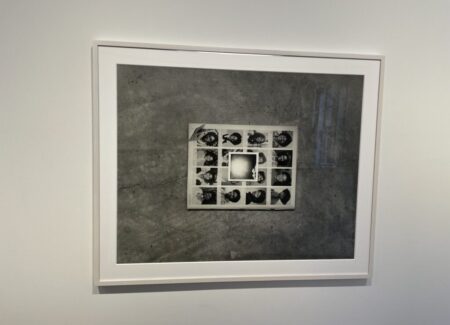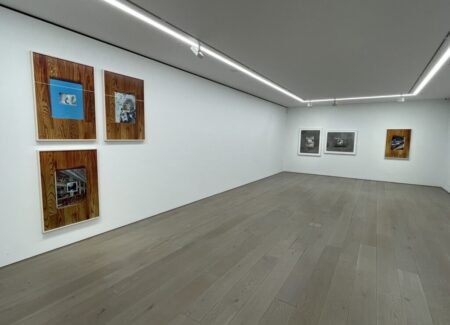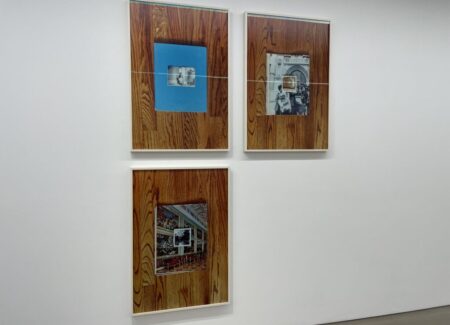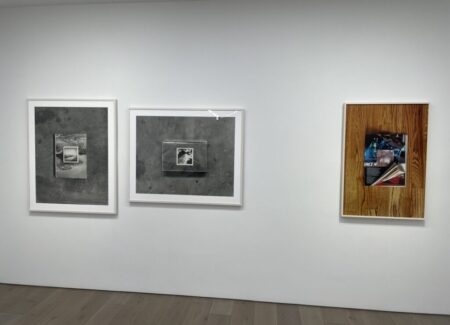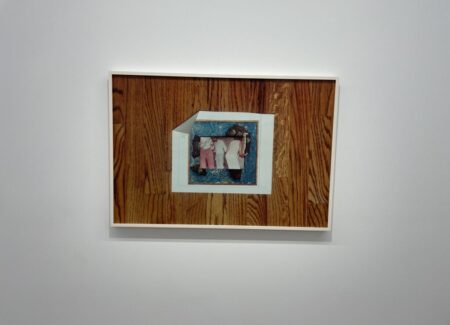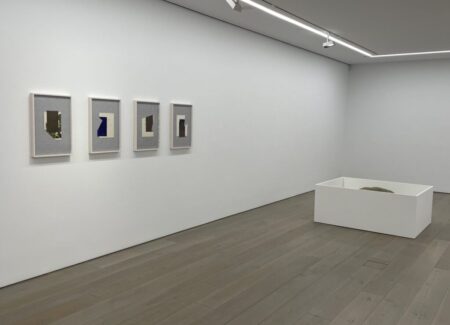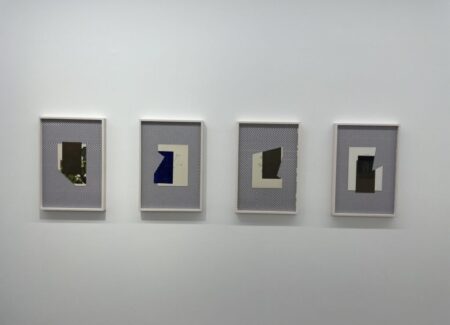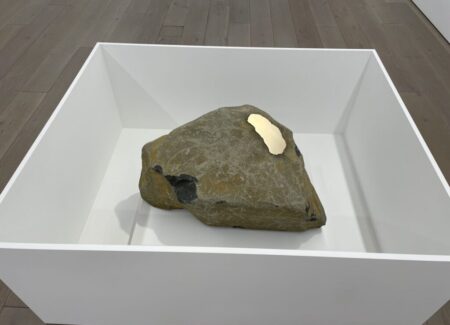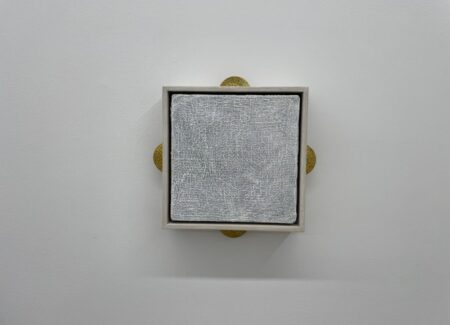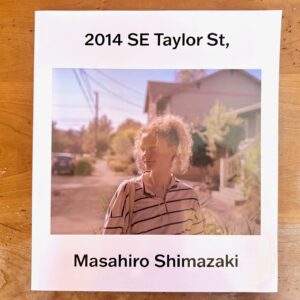JTF (just the facts): A total of 8 photographic works, framed in light wood/white and unmatted/matted, and hung against white walls in a two room gallery space and the entry area on the second floor. (Installation shots below.)
The following works are included in the show:
- 5 chromogenic prints, 2024, sized roughly 30×44, 44×30 inches, in editions of 1+1AP or unique
- 3 gelatin silver prints, 2025, sized roughly 40×49, 49×40 inches, in editions of 1+1AP
- 4 monoprints, 2025, sized roughly 27×17 inches, in editions of 1+1AP
- 1 bronze, white oak (in collaboration with Jamal Cyrus), 2025, sized roughly 13x13x3 inches, unique
- 1 bronze, boulder, 2022, sized 18x32x23 inches, unique
Comments/Context: For some fortunate artists, early on in their artistic careers, they stumble upon an idea that is not only intriguing at that initial moment, but one that turns out to have long lasting creative potential. Perhaps it is the power of a consistent concept, a repeated structure, or a signature styling, but this seemingly simple idea transforms itself into a durable formula of sorts, one that the artist can explore at one moment, and then continue to return to again (and again) over time, without exhausting the richness and ingenuity that made the first examples so exciting.
For Leslie Hewitt, a splash of insight became her “Riffs on Real Time” series, which she first began in 2002. Over the next few years (2002-2005), Hewitt would craft a set of ten images in the series, all using the same general format. She then made another set in the ongoing project from 2006-2009, and yet another in 2012-2017 (as reviewed in a 2013 gallery show here). Of course, along the way, she has made many other compelling bodies of work, in both photography and sculpture, as seen in a 2019 gallery show (reviewed here) and as celebrated by a 2020 Guggenheim Fellowship, and more recently, she has experimented with adding bold blocks of adjacent color to the “Riffs” works. But now more than two decades after she first began the series, this gallery show is centered on a return to “Riffs on Real Time”, with brand new images made in both color (another set of 10) and black-and-white.
The straightforward formula for the images in “Riffs on Real Time” has been remarkably consistent over time. Each photograph documents a three-part sculptural still life arrangement as seen from a top down vantage point. Each assemblage consists of a single vintage/found/amateur snapshot photograph, a single piece of printed ephemera (a book, magazine, catalog, newspaper, or other archival documentation, often drawn from black culture from the 1960s, 1970s, and 1980s), and a base layer of studio flooring underneath (most often wood, but also plush carpets of various colors and patterns or concrete). Each resulting photograph captures a layered, overlapped stack, with the vintage photograph atop the printed ephemera atop the floor, each item partially obscuring the layers below, with the camera spatially flattening the telescoped pile into one geometric plane.
Part of what makes the works from the ongoing “Riffs” project so successful is that they are rarely literal or narrative-driven. More often, Hewitt creates intricate combinations and juxtapositions of imagery and ephemera that are loose and open ended, seemingly connected or related, but not in any specific way. Often there is a sense of collapsed time or nostalgia, with a vintage photograph capturing an overlooked moment of black life from one era, that ephemeral memory then paired with some other piece of printed history from another that creates a tenuous vector of repurposed ideas – “riffs” is an apt characterization, as Hewitt is mixing and linking short visual phrases into her own sense of order, creating wispy rhythms and harmonies that aren’t always as direct or obvious as we might expect.
Several of Hewitt’s new works in color (all of which share a warm wooden floor as the base layer) offer hints of relationships, or perhaps passing cues that allude to compositional echoes. In one work (number 3 of 10), a snapshot of an interior room with a collection of black family photographs arrayed on the wall and atop a bureau is set against an ornate hall filled with oversized paintings and red velvet chairs, creating a repetition of displays and seating, albeit on different scales of grandeur, intimacy, and perhaps historical resonance. In another (number 2 of 10), a photograph of an old style television set, with black family photos sitting on top and a flash of glare off the screen, is combined with a magazine page featuring what looks like a group of black students outside a school building; the time periods are likely different, but the connection between the TV and a newspaper held by one of the students makes a tentative link between versions of mass media and their effects on black life. Still other images in color offer visual improvisations that connect dancing and island motifs, or high technology and old style luxuries (like a silver centerpiece and a chandelier), creating a visual vocabulary of potential associations across passing time.
When Hewitt reduces her palette to the monochrome gradations of black-and-white, her photographs become more overtly textural, and the links between the stacked images become more tactile. The strongest composition in the show features a page of young women’s faces, perhaps a selection of recent college graduates, each black face smiling, hopeful, and off to begin a range of promising careers; this is matched by a flare of sunlight in the sky, the shape of the white glow similar to the black masses of hair worn by the women, the combination of the two formally reinforcing a sense of bright optimism. The other two black-and-white works are even more texture-driven, with a gritty landscape paired with an elongated roadside view and a cloudscape sitting atop the shining surface of a reflective book jacket, the mottled surfaces of both assemblages then further echoed by the cracked and stained concrete floor underneath.
While the show also includes other new non-photographic works, including a series of monoprints and a sculptural boulder, the interruptions in these works are less compelling than those in Hewitt’s stacked imagery. The monoprints use blocks of ink to disrupt floral book plates, introducing geometries that obscure the wildflowers and break up efforts to use them for ordering or classification. Interruption is also the artistic device used in “Birthmark”, a large rounded rock set in a white box with a small area of bronze affixed to the top, the shiny addition creating a new set of potential contexts and readings of the natural form.
As seen in Hewitt’s new photographs, the visual vocabulary developed in the “Riffs on Real Time” works remains compelling, even after multiple compositional iterations over the years. The images function best when they successfully connect what seems like a personal or family memory with a more collective cultural force, allowing us as viewers to find our own familiarities in the resonances between the two. In this way, Hewitt’s stacks become a handy structure for powerfully reinterpreting layers of visual history, fusing private and public lives together with nuance and subtlety.
Collector’s POV: The photographic works in this show are priced at $28000 (black-and-white) or $35000 (color) each, with the monotypes priced at $15000 each. Hewitt’s work has very little secondary market history at this point, so gallery retail likely remains the best option for those collectors interested in following up.
